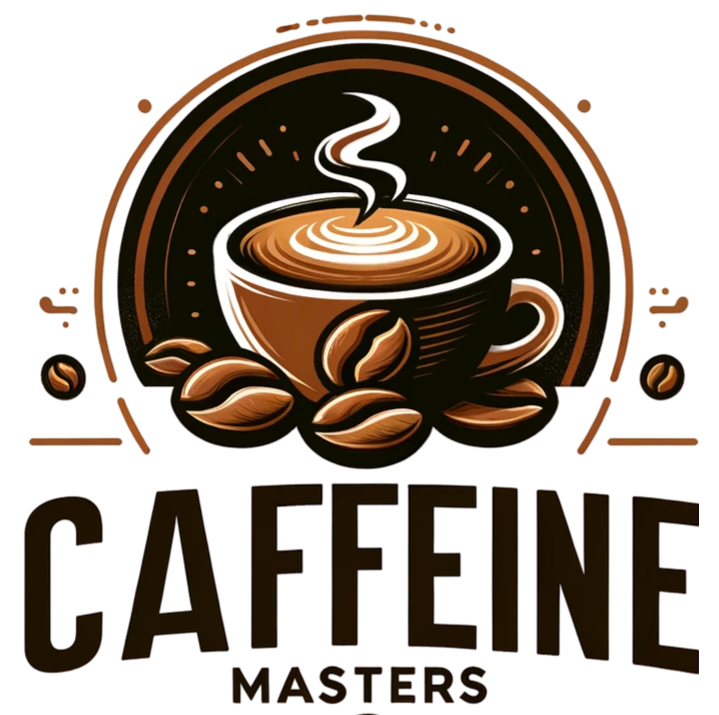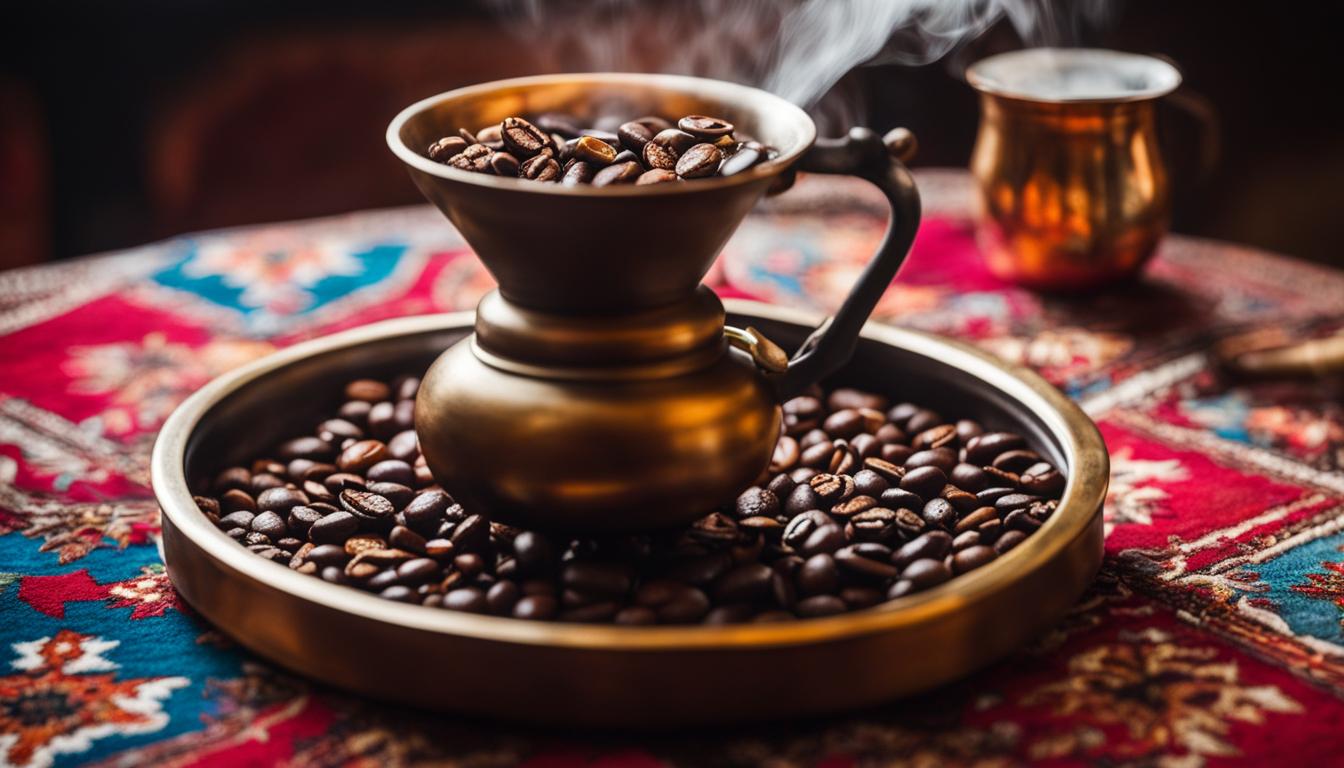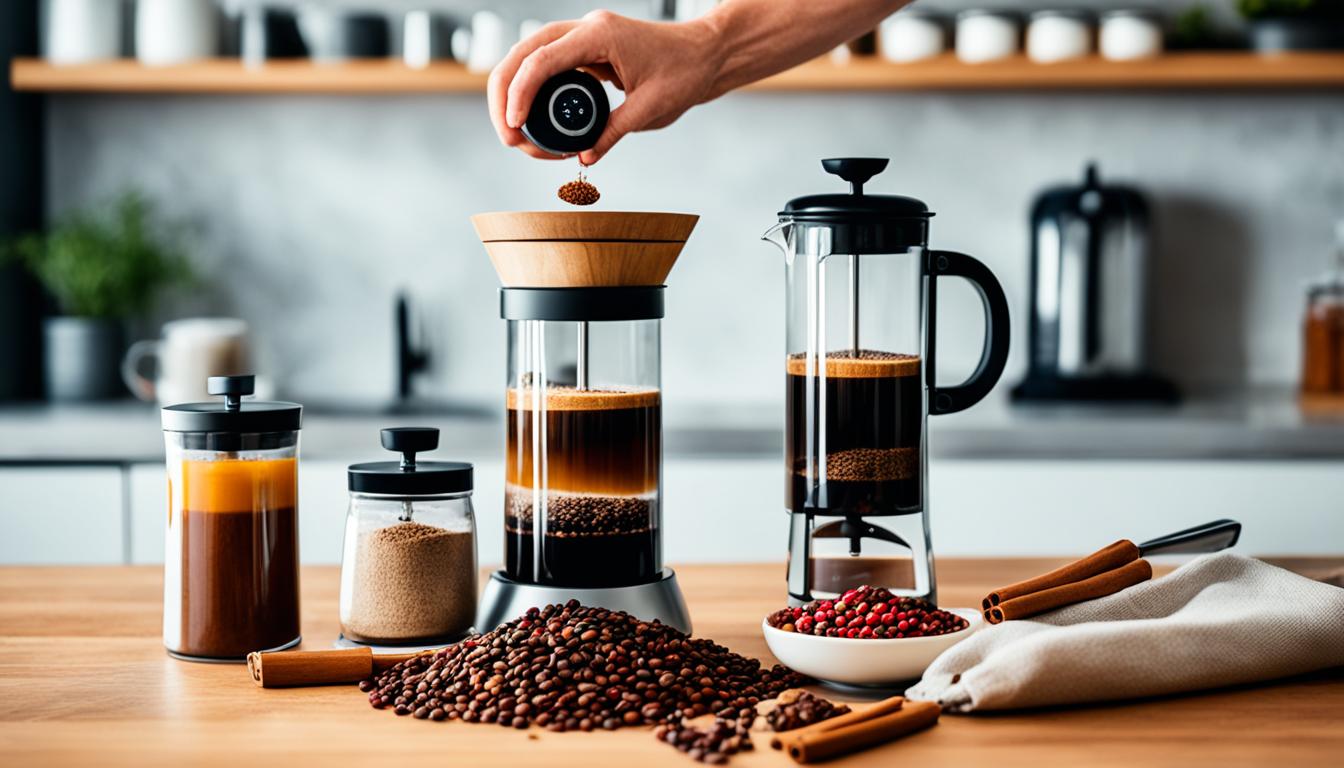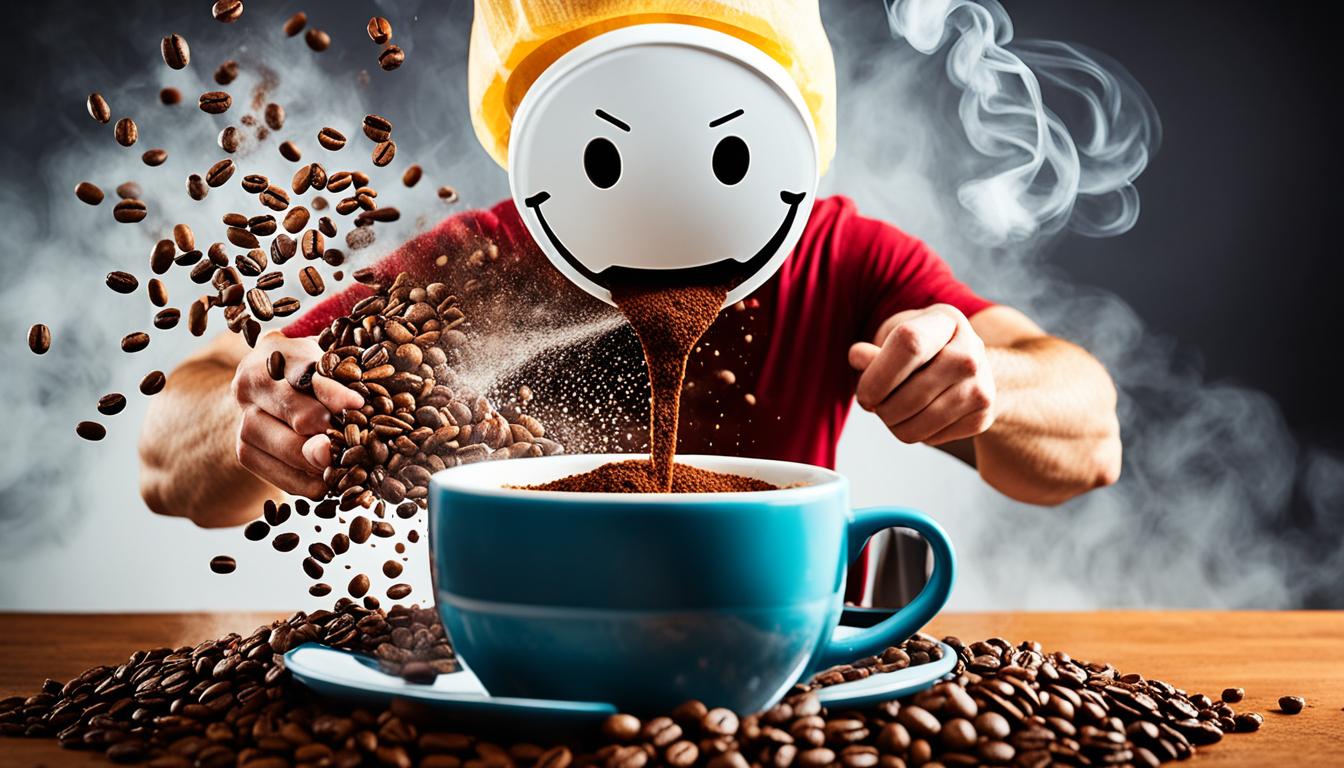Welcome to our guide on understanding coffee extraction, where we dive into the fascinating process of brewing a perfect cup of coffee. Whether you’re a coffee enthusiast or a casual drinker, knowing the ins and outs of coffee extraction can elevate your brewing experience to new heights. In this article, we explore the essential aspects of coffee extraction, the factors that influence it, and how you can achieve optimal results.
When it comes to coffee, the extraction process involves dissolving flavors and compounds from roasted and ground coffee using water. This crucial step profoundly affects the taste and aroma of the final cup you pour. By grasping the intricacies of coffee extraction, you gain better control over the acidity, sweetness, and overall balance in your brew. It’s the key to unlocking the full potential of your favorite beans.
Key Takeaways:
- Coffee extraction is the process of dissolving flavors and compounds from coffee grounds in water.
- Factors such as grind size, water temperature, and brew method significantly impact the extraction process.
- The compounds extracted from coffee directly influence the taste, aroma, and overall balance of the final cup.
- Controlling variables like grind size and water temperature allows for better control over the extraction process.
- Understanding coffee extraction gives you the ability to experiment, discover new flavors, and enhance your coffee brewing skills.
What is Extraction and How Does it Affect Taste?
Extraction is the method by which flavors and other compounds are dissolved from coffee grounds into water during the brewing process. The compounds extracted from coffee, such as caffeine, acids, lipids, sugars, and carbohydrates, directly influence the taste and aroma of the coffee. The extraction process occurs in stages, with fruity and acidic notes being extracted first, followed by sweetness and balance, and finally bitterness. Optimal extraction is necessary to achieve a well-balanced and flavorful cup of coffee.
To understand the importance of optimal coffee extraction, let’s delve deeper into the extraction process. When water comes into contact with the coffee grounds, it dissolves certain compounds and extracts them into the brew. These compounds contribute to the overall flavor profile of the coffee, determining its taste, aroma, body, and complexity.
The extraction process is influenced by various factors, including coffee-to-water ratio, grind size, brew time, water temperature, and more. Achieving the perfect balance of these variables is essential to extracting the ideal amount of flavors and compounds from the coffee grounds.
The Science Behind Coffee Extraction
The extraction process occurs in stages, with fruity and acidic flavors being extracted first, followed by sweetness and balance, and finally bitterness. Each compound has a different solubility in water. Understanding this process allows us to control variables to achieve the desired taste in our cup of coffee.
During the initial stages of extraction, compounds like organic acids, which are responsible for the bright and fruity notes, are quickly extracted into the brewed coffee. As the extraction continues, sugars and carbohydrates are released, contributing to the sweetness and balance of the cup. Finally, if the extraction goes too far, the bitter compounds are extracted, resulting in an unpleasant taste.
Optimal extraction occurs when the desired flavors are extracted without excessive bitterness. The goal is to strike a balance that highlights the unique characteristics of the coffee beans while minimizing any undesirable tastes.
| Variable | Effect on Extraction |
|---|---|
| Grind Size | Affects the surface area of the coffee grounds and extraction rate. Finer grind sizes extract more quickly, while coarser sizes extract more slowly. |
| Brew Time | The duration of contact between water and coffee grounds. Longer brew times extract more flavors, but can also lead to over-extraction if not properly controlled. |
| Water Temperature | Higher temperatures extract more quickly, while lower temperatures result in slower extraction. The ideal temperature range for optimal extraction is typically between 195-205°F (90-96°C). |
| Water Quality | The mineral content and pH of the water can affect extraction. Water with the right balance of minerals and a slightly acidic pH is generally recommended. |
Striking the Right Balance
To achieve optimal coffee extraction, it’s important to experiment with these variables and find the right balance that suits your taste preferences. Adjusting the grind size, brew time, water temperature, and water quality can help you fine-tune the extraction process and unlock the full potential of your coffee beans.
By extracting the desired flavors and compounds without extracting too much bitterness, you can enjoy a well-balanced and flavorful cup of coffee.
How to Control Extraction
In order to achieve the desired level of extraction in coffee brewing, there are several variables that we can control. By understanding and manipulating these variables, we can have more control over the extraction process and ultimately enjoy a better-tasting cup of coffee.
Grind Size: Grind size plays a crucial role in coffee extraction. Finer grounds extract more quickly, while coarser grounds extract more slowly. The size of the coffee grounds determines the surface area available for extraction. For example, if you grind your coffee too fine, it may result in overextraction and a bitter taste. On the other hand, if the grind is too coarse, underextraction may occur, resulting in a weak and underwhelming cup. It is important to find the right grind size that suits your brewing method and personal taste preferences.
Brew Method: The brew method you choose also affects coffee extraction. Different methods, such as pour over or French press, have varying extraction times. A longer brew time typically leads to more extraction, resulting in a stronger and more flavorful cup of coffee. It is important to consider the recommended brew time for your chosen method and adjust accordingly.
Water Temperature: Water temperature is another crucial variable that influences extraction. The optimal water temperature for coffee extraction is typically between 195-205°F (90-96°C). Water that is too hot can lead to overextraction and a bitter taste, while water that is too cool may result in underextraction and a weak cup. Finding the right water temperature for your brewing method is key to achieving a well-balanced and flavorful cup of coffee.
Bed Depth: The thickness of the coffee bed, also known as bed depth, can impact extraction as well. A consistent and even bed depth ensures that the water flows evenly through the coffee grounds, allowing for uniform extraction. Uneven bed depths may result in uneven extraction, leading to an imbalanced and inconsistent cup of coffee.
By adjusting these variables – grind size, brew method, water temperature, and bed depth – we can fine-tune the extraction process to achieve the desired taste profile in our coffee. Experimentation is key to finding the optimal combination of variables that suits your personal preference. With practice and a better understanding of these key factors, you can elevate your coffee brewing skills and enjoy a delicious cup of coffee every time.
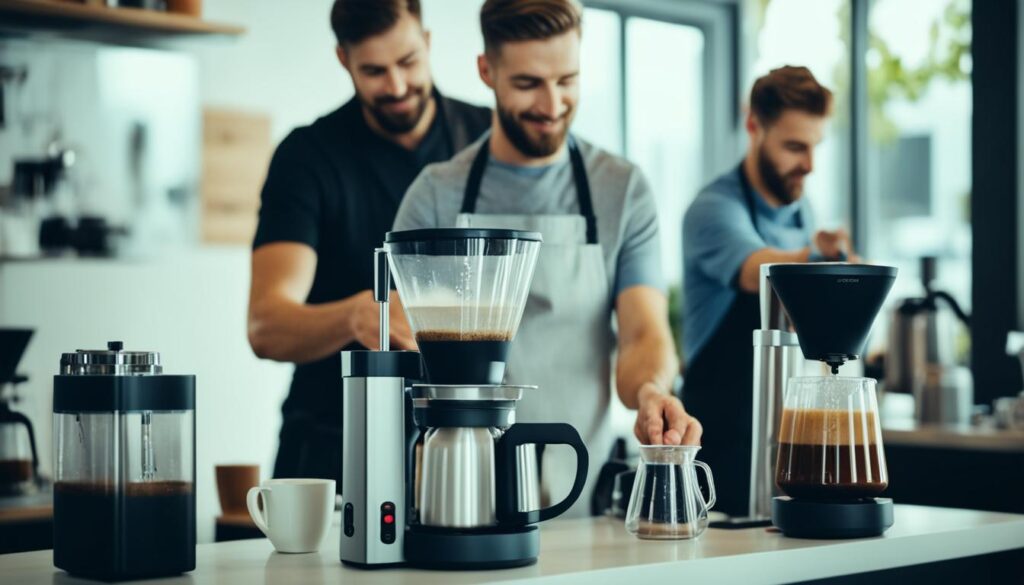
| Variable | Impact on Extraction |
|---|---|
| Grind Size | Determines the rate of extraction – finer grounds extract more quickly, while coarser grounds extract more slowly. |
| Brew Method | Affects extraction time – longer brew times typically result in more extraction. |
| Water Temperature | Optimal temperature range of 195-205°F (90-96°C) for proper extraction. |
| Bed Depth | A consistent and even bed depth ensures uniform extraction. |
Variables That Influence Extraction
When it comes to coffee extraction, several variables come into play, each impacting the final flavor profile of your cup. Understanding these variables and how they interact is crucial for achieving the optimal level of extraction and unlocking the true potential of your coffee beans.
Coffee Bean Genetic Characteristics
Every coffee bean has its own unique genetic makeup, which affects how it will extract during brewing. Factors such as variety, origin, and processing methods can influence the solubility of the coffee compounds, ultimately determining the flavors that are extracted. For example, certain varieties like Ethiopian or Kenyan beans may yield more fruity and vibrant notes, while others like Brazilian beans may exhibit more nutty and chocolatey flavors. Exploring different bean characteristics allows us to experiment with diverse flavor profiles.
Grind Size
The grind size of your coffee grounds plays a crucial role in extraction. Finer grounds have a larger surface area, allowing for faster extraction of flavors. On the other hand, coarser grounds have a smaller surface area, resulting in a slower and more controlled extraction process. It’s essential to adjust the grind size according to your brewing method to ensure optimal extraction. For example, espresso requires a finer grind, while pour-over methods benefit from a medium grind.
Brew Method
The brewing method you choose significantly impacts extraction. Each method has its own recommended grind size and brewing time, which determine how much flavor is extracted from the coffee grounds. For instance, espresso brewing tends to have a short extraction time due to the high-pressure brewing process, resulting in a concentrated and intense flavor profile. On the other hand, the pour-over method allows for a longer brewing time, extracting a balanced range of flavors.
Water Temperature
Water temperature is another critical variable to consider. Higher temperatures generally lead to faster extraction, as heat accelerates the dissolution of coffee compounds. However, overly hot water can also result in over-extraction and bitterness. It’s essential to find the optimal temperature range for your desired taste. The Specialty Coffee Association recommends a temperature range of 195-205°F (90-96°C) for optimal extraction.
Water Quality
Lastly, water quality can greatly impact extraction. The pH level and mineral content of the water can affect the solubility of coffee compounds, leading to variations in flavor extraction. Water with a balanced pH level and appropriate mineral content, such as filtered or bottled water, provides a clean canvas for achieving consistent extraction.
By understanding and manipulating these variables, you can take control of your coffee extraction process and achieve the desired flavor profile in your cup. Experimenting with different combinations and fine-tuning these variables allows you to explore a wide range of flavors and unlock the true potential of each coffee bean.
| Variable | Impact on Extraction |
|---|---|
| Coffee Bean Genetic Characteristics | Determines the solubility of coffee compounds and influences the flavor profile. |
| Grind Size | Finer grounds extract more quickly, while coarser grounds extract more slowly. |
| Brew Method | Different methods require varying grind sizes and brewing times, resulting in diverse flavor profiles. |
| Water Temperature | Higher temperatures accelerate extraction, but excessive heat can lead to over-extraction and bitterness. |
| Water Quality | The pH level and mineral content in water affect the solubility of coffee compounds. |
Conclusion
Understanding coffee extraction is essential for achieving the perfect cup of coffee. By controlling variables such as grind size, brew method, water temperature, and water quality, you can achieve the optimal level of extraction and unlock the full potential of your coffee beans.
Experimenting with different techniques and variables can help you discover new flavors and improve your brewing skills. Whether it’s adjusting the grind size to fine-tune the extraction or trying out different brew methods to find your preferred flavor profile, exploring coffee extraction techniques allows you to customize your coffee experience.
With a better understanding of coffee extraction, you can enhance your coffee expertise and enjoy a delicious cup of coffee every time. So, grab your favorite coffee beans, experiment with extraction techniques, and elevate your coffee brewing game to new heights.
FAQ
What is coffee extraction?
Coffee extraction is the process of dissolving flavors and other compounds from roasted and ground coffee using water during brewing.
How does extraction affect the taste of coffee?
The compounds extracted from coffee directly influence the taste and aroma of the coffee. Optimal extraction is crucial for achieving a well-balanced and flavorful cup of coffee.
How can I control coffee extraction?
You can control coffee extraction by adjusting variables such as grind size, brew method, water temperature, and bed depth.
What variables influence coffee extraction?
Variables that influence coffee extraction include coffee bean genetic characteristics, grind size, brew method, water temperature, and water quality.
Why is understanding coffee extraction important?
Understanding coffee extraction allows you to have more control over the brewing process and achieve a better-tasting cup of coffee.
